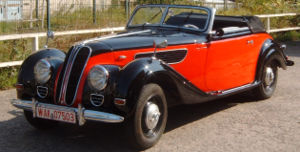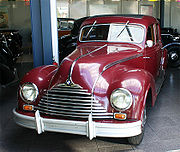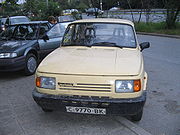
Automobilwerk Eisenach
Encyclopedia

Automobile
An automobile, autocar, motor car or car is a wheeled motor vehicle used for transporting passengers, which also carries its own engine or motor...
manufacturer in Eisenach
Eisenach
Eisenach is a city in Thuringia, Germany. It is situated between the northern foothills of the Thuringian Forest and the Hainich National Park. Its population in 2006 was 43,626.-History:...
, Germany
Germany
Germany , officially the Federal Republic of Germany , is a federal parliamentary republic in Europe. The country consists of 16 states while the capital and largest city is Berlin. Germany covers an area of 357,021 km2 and has a largely temperate seasonal climate...
.
Fahrzeugfabrik Eisenach
Heinrich Ehrhardt founded the Fahrzeugfabrik Eisenach (FFE) in Eisenach on 3 December 1896 as a stock company. Initially he produced bicycleBicycle
A bicycle, also known as a bike, pushbike or cycle, is a human-powered, pedal-driven, single-track vehicle, having two wheels attached to a frame, one behind the other. A person who rides a bicycle is called a cyclist, or bicyclist....
s and gun
Gun
A gun is a muzzle or breech-loaded projectile-firing weapon. There are various definitions depending on the nation and branch of service. A "gun" may be distinguished from other firearms in being a crew-served weapon such as a howitzer or mortar, as opposed to a small arm like a rifle or pistol,...
s, but after two years he started to produce a motor car which he called the Wartburg, a licensed model of the French Decauville
Décauville automobile
Decauville was a French automobile maker, a subsidiary of a company already famous for producing locomotives.The company was registered as Société des Voitures Automobiles Decauville in 1897 and the factory started producing automobiles in 1898. The first car was designed by Messrs Joseph Guédon...
. The company was the third to manufacture cars in Germany after Daimler Motoren Gesellschaft
Daimler Motoren Gesellschaft
Daimler-Motoren-Gesellschaft was a German engine and later automobile manufacturer, in operation from 1890 until 1926. Founded by Gottlieb Daimler and Wilhelm Maybach, it was based first in Cannstatt...
and Benz & Cie
Karl Benz
Karl Friedrich Benz, was a German engine designer and car engineer, generally regarded as the inventor of the gasoline-powered car, and together with Bertha Benz pioneering founder of the automobile manufacturer Mercedes-Benz...
, which later merged to become Mercedes-Benz
Mercedes-Benz
Mercedes-Benz is a German manufacturer of automobiles, buses, coaches, and trucks. Mercedes-Benz is a division of its parent company, Daimler AG...
. His son Gustav took over the factory that at the end of the 19th century employed 1,300 workers, being one of the largest in Thuringia
Thuringia
The Free State of Thuringia is a state of Germany, located in the central part of the country.It has an area of and 2.29 million inhabitants, making it the sixth smallest by area and the fifth smallest by population of Germany's sixteen states....
.
Reorganized as Dixi
In 1903, the Ehrhardt family withdrew from management due to financial losses and also because the license to build Decauvilles was revoked. The factory began building under the new name, Dixi (LatinLatin
Latin is an Italic language originally spoken in Latium and Ancient Rome. It, along with most European languages, is a descendant of the ancient Proto-Indo-European language. Although it is considered a dead language, a number of scholars and members of the Christian clergy speak it fluently, and...
, “I have spoken”) in 1904 with Willi Seck as chief engineer. The top model, the type U35, was introduced in 1907 and was soon recognized for its reliability and performance with 65 hp
Horsepower
Horsepower is the name of several units of measurement of power. The most common definitions equal between 735.5 and 750 watts.Horsepower was originally defined to compare the output of steam engines with the power of draft horses in continuous operation. The unit was widely adopted to measure the...
(48 kW) and a top speed of 85 km/h (53 mph).
During World War I
World War I
World War I , which was predominantly called the World War or the Great War from its occurrence until 1939, and the First World War or World War I thereafter, was a major war centred in Europe that began on 28 July 1914 and lasted until 11 November 1918...
the company produced trucks and guns. Afterwards the factory suffered from reparations
War reparations
War reparations are payments intended to cover damage or injury during a war. Generally, the term war reparations refers to money or goods changing hands, rather than such property transfers as the annexation of land.- History :...
with removal of equipment. In 1919, car production resumed; but soon economic hardship forced a merger with Gothaer Waggonfabrik
Gothaer Waggonfabrik
Gothaer Waggonfabrik was a German manufacturer of rolling stock established in the late nineteenth century at Gotha. During the two world wars, the company expanded into aircraft building.-World War I:...
AG. Another result of the economic downturn was a change in output, focusing on small cars. In 1927 Dixi produced the DA-1 3/15, a version of the British Austin 7
Austin 7
The Austin 7 was a car produced from 1922 through to 1939 in the United Kingdom by the Austin Motor Company. Nicknamed the "Baby Austin", it was one of the most popular cars ever produced for the British market, and sold well abroad...
built under licence.
BMW takes over
In November 1928 BMWBMW
Bayerische Motoren Werke AG is a German automobile, motorcycle and engine manufacturing company founded in 1916. It also owns and produces the Mini marque, and is the parent company of Rolls-Royce Motor Cars. BMW produces motorcycles under BMW Motorrad and Husqvarna brands...
acquired the Fahrzeugfabrik Eisenach A.G. (Marke "Dixi") from the Gothaer Waggonfabrik bringing the independent existence of Dixi to an end and the Eisenach factory became the birthplace of car manufacturing by BMW. The Dixi continued briefly as the BMW Dixi
BMW Dixi
The Dixi was the first car made by BMW.thumb|right|280px|1928 BMW DixiDixi was car brand of Eisenach car factory made from 1904; however, in the difficult climate of the 1920s the company found it hard to sell its 6/24 and 9/40 models...
but the renamed BMW-Factory Eisenach soon started making an updated version of the car called the BMW 3/15
BMW 3/15
The BMW 3/15 was BMW's first car, produced in four versions from December 1927 to early 1932. 18,976 BMW 3/15s were manufactured between 1929 and 1932.- 3/15 DA-1 :...
PS dropping the Dixi name. By 1931, 25000 cars had been produced in a series going from DA 1 to DA 4. The DA-3, a sporting version, saw a re-appearance of the Wartburg name. In 1932 a new small car, the 3/20 AM-1, was announced with independent suspension all round and an enlarged 788cc (48ci) engine.
In 1930 BMW also started to produce motorcycles at Eisenach. The 1937 introduced BMW R 35 was the most notable product.
In 1933 BMW started to develop bigger cars with 6-cylinder engines. The first car of which was the BMW 303
BMW 303
The BMW 303 was a middle sized saloon produced by BMW in 1933 and 1934. It was the first BMW to use the 'kidney grill' which today is a hallmark of the company's models....
. Later successors were the BMW 315
BMW 315
The BMW 315 was a middle sized saloon produced by BMW from 1934 to 1937. It was based on the BMW 303. It differed from the 303 mainly with its larger engine, with increases in both the bore and the stroke ....
, BMW 319, BMW 327
BMW 327
The BMW 327 is a medium sized touring coupé produced by the Bavarian firm between 1937 and 1941, and again produced after 1945. It sat on a shortened version of the BMW 326 chassis.-Launch:...
and the elegant sports coupe BMW 328
BMW 328
The BMW 328 is a sports car made by BMW between 1936 and 1940, with the body design credited to Peter Szymanowski, who became BMW chief of design after World War II ....
.
In 1942 regular automobile production was stopped because of World War II
World War II
World War II, or the Second World War , was a global conflict lasting from 1939 to 1945, involving most of the world's nations—including all of the great powers—eventually forming two opposing military alliances: the Allies and the Axis...
. The BMW factory in Eisenach started to manufacture motorcycle
Motorcycle
A motorcycle is a single-track, two-wheeled motor vehicle. Motorcycles vary considerably depending on the task for which they are designed, such as long distance travel, navigating congested urban traffic, cruising, sport and racing, or off-road conditions.Motorcycles are one of the most...
s for the Wehrmacht
Wehrmacht
The Wehrmacht – from , to defend and , the might/power) were the unified armed forces of Nazi Germany from 1935 to 1945. It consisted of the Heer , the Kriegsmarine and the Luftwaffe .-Origin and use of the term:...
as well as aircraft engines for the Luftwaffe
Luftwaffe
Luftwaffe is a generic German term for an air force. It is also the official name for two of the four historic German air forces, the Wehrmacht air arm founded in 1935 and disbanded in 1946; and the current Bundeswehr air arm founded in 1956....
. By the end of the war about 60% of the factory was destroyed.
After the War: EMW/BMW

United States Army
The United States Army is the main branch of the United States Armed Forces responsible for land-based military operations. It is the largest and oldest established branch of the U.S. military, and is one of seven U.S. uniformed services...
handed Thuringia over to the Soviets
Soviet Union
The Soviet Union , officially the Union of Soviet Socialist Republics , was a constitutionally socialist state that existed in Eurasia between 1922 and 1991....
, the factory became a Soviet Stock company under the direction of the SMAD
Soviet Military Administration in Germany
The Soviet Military Administration in Germany was the Soviet military government, headquartered in Berlin-Karlshorst, that directly ruled the Soviet occupation zone of Germany from the German surrender in May 1945 until after the establishment of the German Democratic Republic in October...
, and was renamed Sowjetische AG Maschinenbau Awtowelo, Werk BMW Eisenach (Soviet Awtowelo Co., Eisenach BMW Works). Production restarted with the BMW 321
BMW 321
The BMW 321 is a compact six cylinder sedan sedan produced by the Bavarian firm between 1938 and 1941. After 1945, production resumed at the Eisenach plant: 321s were built again between approximately 1945 and 1950, probably in greater numbers than before the war.-The launch:The 321 was introduced...
, of which almost 4,000 were made between late 1945 and 1950. A handful of BMW 326
BMW 326
The BMW 326 is a relatively rapid medium sized sedan produced by the Bavarian firm between 1936 and 1941, and again briefly after 1945. It had an innovative design and sold well despite its relatively high price...
s were made in 1946-7 and 161 BMW 325-2s were made in 1952.
In 1949 the Eisenach works launched the BMW 340
BMW 340
The BMW 340, subsequently rebadged as the EMW 340, was a large six cylinder four door passenger saloon produced at Eisenach initially in the name of BMW. Five door 340 station wagons were also manufactured...
(a development of the BMW 326
BMW 326
The BMW 326 is a relatively rapid medium sized sedan produced by the Bavarian firm between 1936 and 1941, and again briefly after 1945. It had an innovative design and sold well despite its relatively high price...
with modified front and rear bodywork) and the BMW 327
BMW 327
The BMW 327 is a medium sized touring coupé produced by the Bavarian firm between 1937 and 1941, and again produced after 1945. It sat on a shortened version of the BMW 326 chassis.-Launch:...
.
As long as the Soviets owned the company, BMW in Munich could not bring legal proceedings to protect its tradename. As the Munich
Munich
Munich The city's motto is "" . Before 2006, it was "Weltstadt mit Herz" . Its native name, , is derived from the Old High German Munichen, meaning "by the monks' place". The city's name derives from the monks of the Benedictine order who founded the city; hence the monk depicted on the city's coat...
factory was not producing cars yet, all "BMWs" made from 1945 to 1951 are Eisenach products.
In 1952 the works were transferred to ownership by the East German government and renamed EMW or Eisenacher Motorenwerk (see below). It continued type 327 production and further developed the type 340 as the EMW 340-2. Production of both models ceased in 1955, by which time Eisenach had produced a total of over 21,200 BMW/EMW 340s and 400 BMW/EMW 327s. Total production of four-stroke automobiles between 1945 and 1955 was just over 30,800.
VEB Automobilwerk Eisenach
_02.jpg)
Logo
A logo is a graphic mark or emblem commonly used by commercial enterprises, organizations and even individuals to aid and promote instant public recognition...
, and typical double-nostril grille appearance, and started to produce cars again. The Eisenach company was renamed Eisenacher Motorenwerk
Eisenacher Motorenwerk
Eisenacher Motorenwerk was an East German manufacturer of automobiles and motorcycles based in Eisenach. EMW also entered Formula One as a constructor in 1953, but participated in only one race, the 1953 German Grand Prix....
(EMW), its logo being a variation of the BMW logo. EMW participated in the 1953 German Grand Prix
1953 German Grand Prix
The 1953 German Grand Prix was a Formula Two race held on August 2, 1953 at the Nürburgring Nordschleife. It was the seventh round of the 1953 World Drivers' Championship, which was run to Formula Two rules in 1952 and 1953, rather than the Formula One regulations normally used.- Classification :-...
. One year later it received its final name VEB
Volkseigener Betrieb
The Volkseigener Betrieb was the legal form of industrial enterprise in East Germany...
Automobilwerk Eisenach (AWE).

Industrieverband Fahrzeugbau
Industrieverband Fahrzeugbau , usually abbreviated as IFA, was a conglomerate and a union of companies for vehicle construction in the former East Germany ....
309. This was based on a DKW prototype, the F9, that was developed in 1939 but not put into production. The manufacture of models derived from pre-war BMWs finished at the end of 1955 (see above).
In 1956 the first Wartburg (Type 311 and later the 312) was launched with a new design but maintaining the DKW based two-stroke engine. The Wartburg 353, introduced in 1966, received a new body but still used the two-stroke engine, now with a displacement of 1000 cc.. Many new ideas were proposed by the engineers but they were not accepted by the state authorities. Finally, in 1988 four cylinder four-stroke engines produced by Volkswagen
Volkswagen
Volkswagen is a German automobile manufacturer and is the original and biggest-selling marque of the Volkswagen Group, which now also owns the Audi, Bentley, Bugatti, Lamborghini, SEAT, and Škoda marques and the truck manufacturer Scania.Volkswagen means "people's car" in German, where it is...
were introduced.

Suspension (motorcycle)
A motorcycle's suspension serves a dual purpose: contributing to the vehicle's handling and braking, and providing safety and comfort by keeping the vehicle's passengers comfortably isolated from road noise, bumps and vibrations....
. Eisenach built just over 83,000 of the R35 and its variants before its motorcycle production was ended in 1955.
Closure after reunification
The German reunificationGerman reunification
German reunification was the process in 1990 in which the German Democratic Republic joined the Federal Republic of Germany , and when Berlin reunited into a single city, as provided by its then Grundgesetz constitution Article 23. The start of this process is commonly referred by Germans as die...
meant the end for AWE, as it could not compete with modern methods of production and the Treuhand
Treuhand
The Treuhandanstalt was the agency that privatized the East German enterprises, Volkseigener Betrieb , owned as public property. Created by the Volkskammer on June 17, 1990, it oversaw the restructuring and selling of about 8,500 firms with initially over 4 million employees...
agency closed it in 1991. A good number of the employees found work in the newly created Opel
Opel
Adam Opel AG, generally shortened to Opel, is a German automobile company founded by Adam Opel in 1862. Opel has been building automobiles since 1899, and became an Aktiengesellschaft in 1929...
factory, opened in Eisenach in 1992.
While most of the factory has been demolished, one part (Building O2) has been preserved to house the Automobilbaumuseum Eisenach (Eisenach Car Museum).
Production table for cars manufactured 1898 - 1991
| Time period | Model | Production (Cars) |
|---|---|---|
| 1898–1903 | Wartburg-Motorwagen | ca. 250 |
| 1904–1927 | Dixi-PKW | 6090 |
| 1907–1927 | Dixi-LKW | 2,622 |
| 1907–1928 | Dixi-Kleinwagen DA 1 | 9,308 |
| 1929–1942 | BMW DA 2, DA 3, DA 4, BMW 303, 309, 315, 319, 319/1, 329, 320, 321, 325, 326, 327, 328, 335 | 78,768 |
| 1945–1950 | Post-WWII - BMW 321 | 8,996 |
| 1946–1947 | Post-WWII - BMW 326 | 16 |
| 1952–1955 | BMW / EMW 327-1, 327-2, 327-3 | 505 |
| 1949–1955 | BMW / EMW 340, 340-1, 340-2 | 21,083 |
| 1952 | Kübelwagen IFA EMW 325-3 | 166 |
| 1953–1956 | IFA F9 | 38,782 |
| 1955–1965 | Wartburg 311/312 | 258,928 |
| 1957–1960 | Wartburg-Sport 313-1 | 469 |
| 1965–1966 | Wartburg 312-1 | 33,759 |
| 1966–1975 | Wartburg 353 | 356,330 |
| 1975–1988 | Wartburg 353 W | 868,860 |
| 1988–1991 | Wartburg 1.3 | 152,775 |
| r"> Total production | 1,837,708 | |

